Growing up, ads on the television taught me that ‘anything is possible’ on your period.
A flowery depiction of the menstrual cycle, women were generally shown looking carefree as they frolicked in tennis whites or took spin cycle classes — but my reality was very different.
For years, I have dealt with the telltale signs that my period is coming, from headaches and bloating to mood changes and an overwhelming craving for something sweet. And I’m not alone.
According to the Office on Women’s Health, nine out of 10 women suffer from PMS, and many miss work or school due to the severity of their premenstrual symptoms.
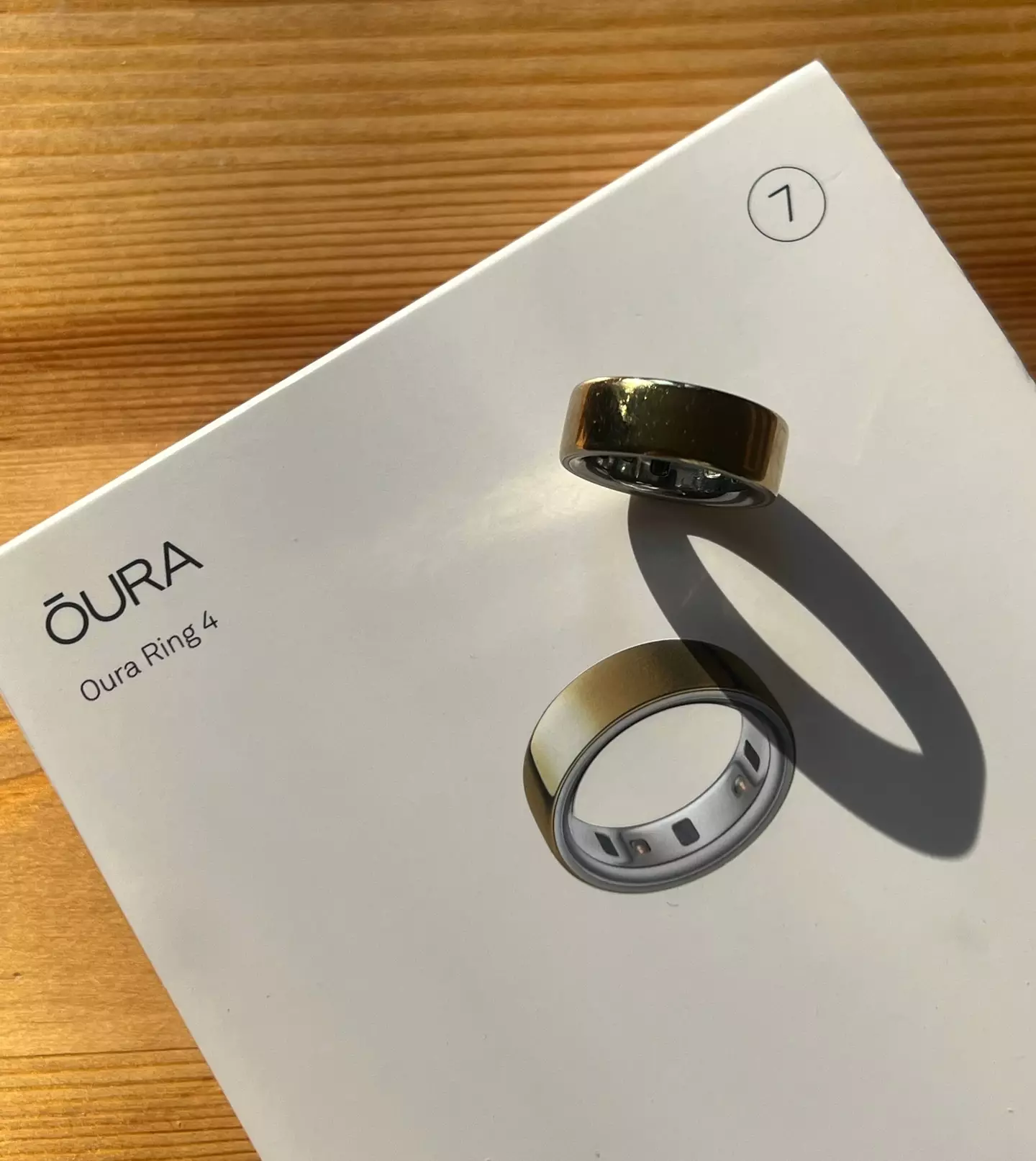

The Oura Ring 4 comes with a sizing kit to find the perfect fit
At 31, I had come to accept this as just part of my everyday life, until I stumbled across something that might finally give me some answers: the Oura Ring.
What is the Oura ring?
Made famous by the likes of Gwyneth Paltrow, Jennifer Aniston, and Kim Kardashian, the smart piece of jewelry is designed to give users a holistic picture of their health and wellbeing by constant monitoring.
An upgrade on the previous model (3), the Oura Ring 4 uses smart sensing to deliver health data, 24 hours a day. Red and infrared LEDs measure blood oxygen levels whilst you sleep while green and infrared PPG sensors take charge of monitoring your heart rate.
There’s even an accelerometer that logs every step, workout, and calorie burned (note: you can turn this feature off).
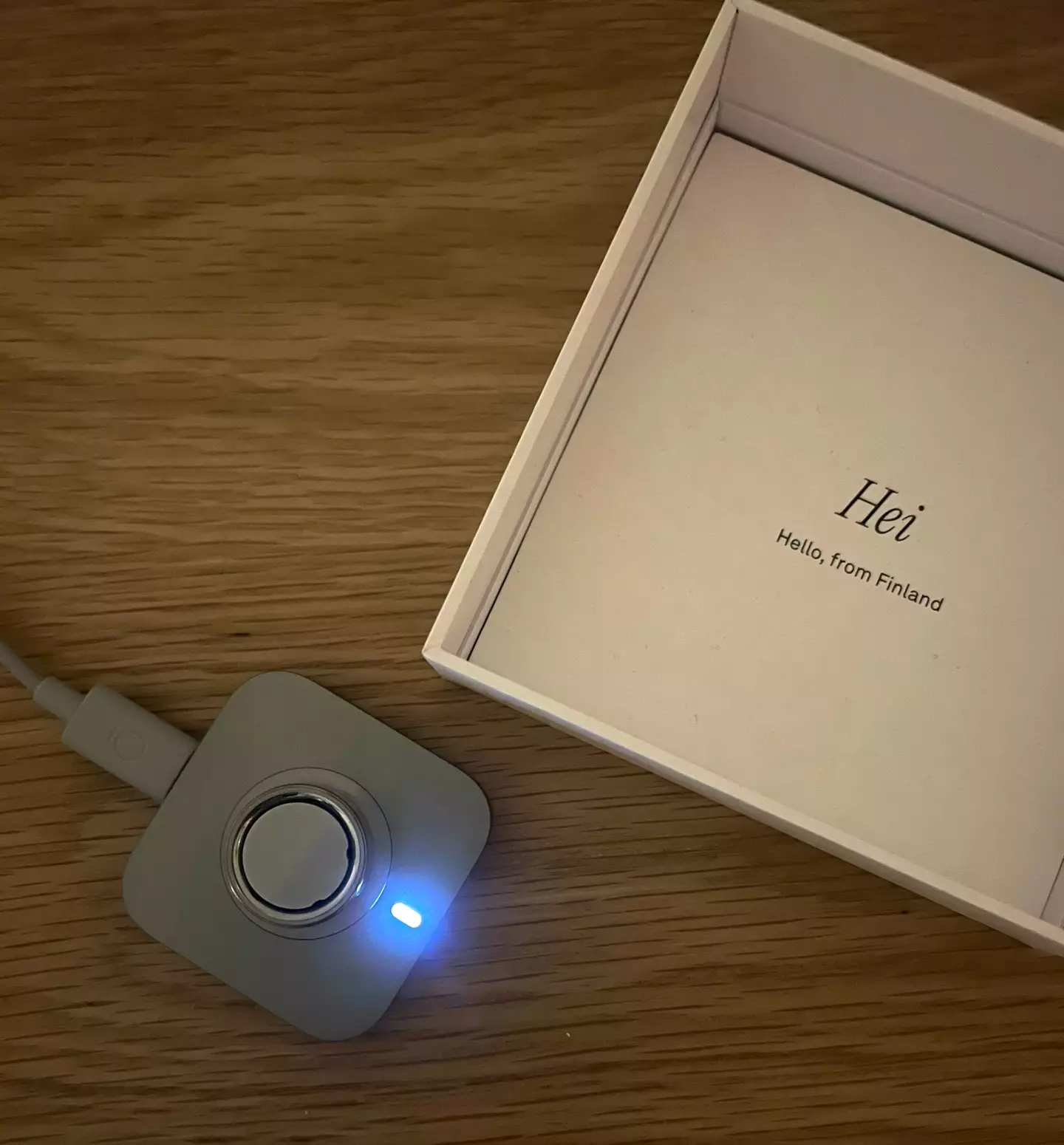

Unboxing the Oura Ring 4
How does the Oura ring track your periods?
But what I was most interested in is Cycle Insights, a feature that allows women to track their periods and adapt their lifestyle to align with each stage of their menstrual cycle.
Valentine Milanoca, founder of leading virtual women’s health clinic Daye, has noticed an increase in people wanting to learn more about their menstrual health, and believes wearable technology could help to achieve this.
“There’s been a cultural shift towards de-stigmatising menstruation and promoting menstrual literacy, which has empowered people to seek information and take control of their health,” Milanoca explains.
“Wearable technology provides a more streamlined, and potentially more accurate, way to track cycles compared to traditional methods.”
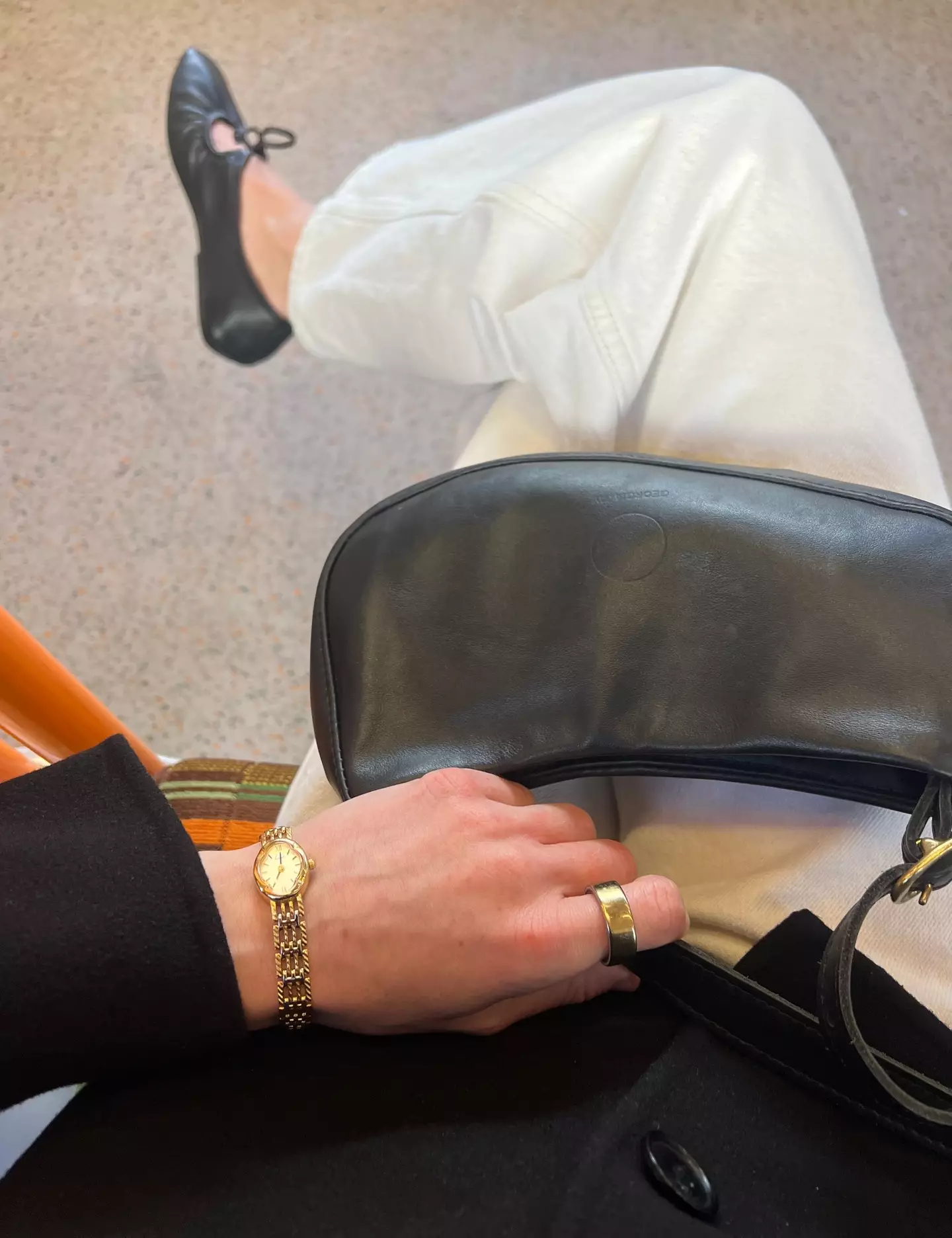

You wouldn’t even know it’s a smart ring
“This data empowers women to make informed decisions about their health and lifestyle.”
Intrigued to see if wearable tech could help me to finally take control of my menstrual health, I decided to test the new Oura Ring 4 for three months, and something surprising happened.
The Oura Ring 4: Pros
First things first: I was admittedly drawn to the ring’s sleek, minimal design. There are six colours to choose from: silver ($349), black ($349), brushed silver ($399), stealth ($399), gold ($499), and rose gold ($499). I chose the gold colourway, as it fits seamlessly into my jewellery collection, and friends were surprised when I told them it was a fitness tracker – you’d never catch me wearing a Fitbit.
Aesthetics aside, did it accurately track my periods? In short, yes.
Until purchasing the Oura Ring, I didn’t know when my period would arrive, though it would later become clear why I’d been sobbing into my pillow the night before.
After three months of use, the Oura Ring will be able to use your nightly average body temperature and HRV (variation in time between consecutive heartbeats), to create a period prediction window. This data can be found on Oura’s ‘Cycle Insights‘ feature, where you can see which stage of the menstrual cycle you are in.
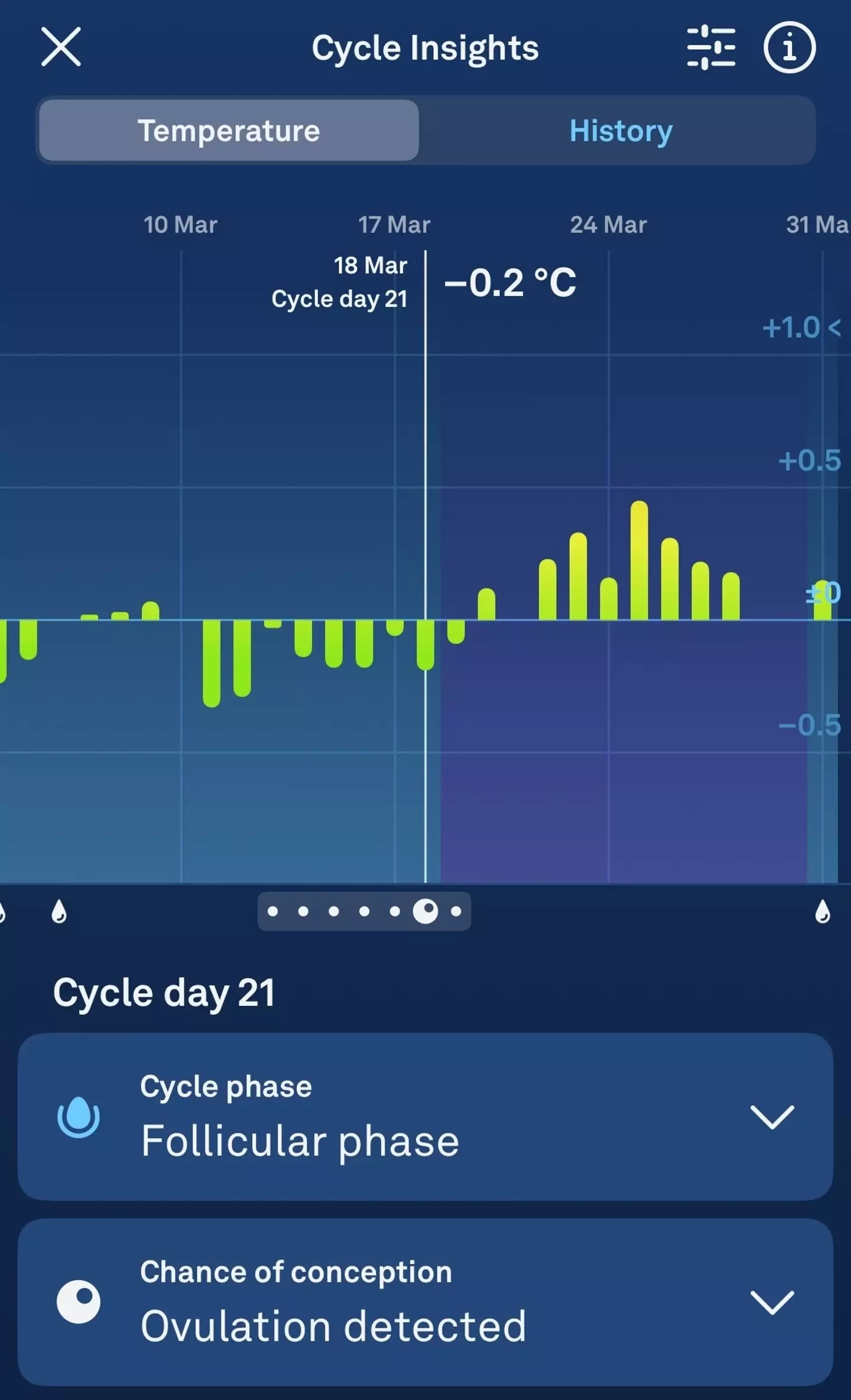

The Oura Ring will track your temperature to help predict your next period
For instance, during the luteal phase, your temperature rises, your heart rate increases, and your HRV levels dip, to indicate that your period is coming. The luteal phase marks the second half of the menstrual cycle, during which time your body prepares the uterus for a potential pregnancy by thickening the uterine and releasing progesterone.
Not only will the Oura app warn you that your period is due, but it will even help you to make changes in your lifestyle depending on the stage of your cycle.
For example, the app will change my activity goal during the luteal phase to encourage me to take things easy and prioritise rest. During the follicular phase (which typically begins on the first day of menstruation), I’m encouraged to be creative and take advantage of the sudden boost in estrogen to tackle work or fun projects.
In the days before Oura, I wouldn’t have listened to my body, and would have pushed through daily workouts or work commitments without a second thought. Now, I have a deeper understanding of my mood and symptoms – and I’m kinder to myself.
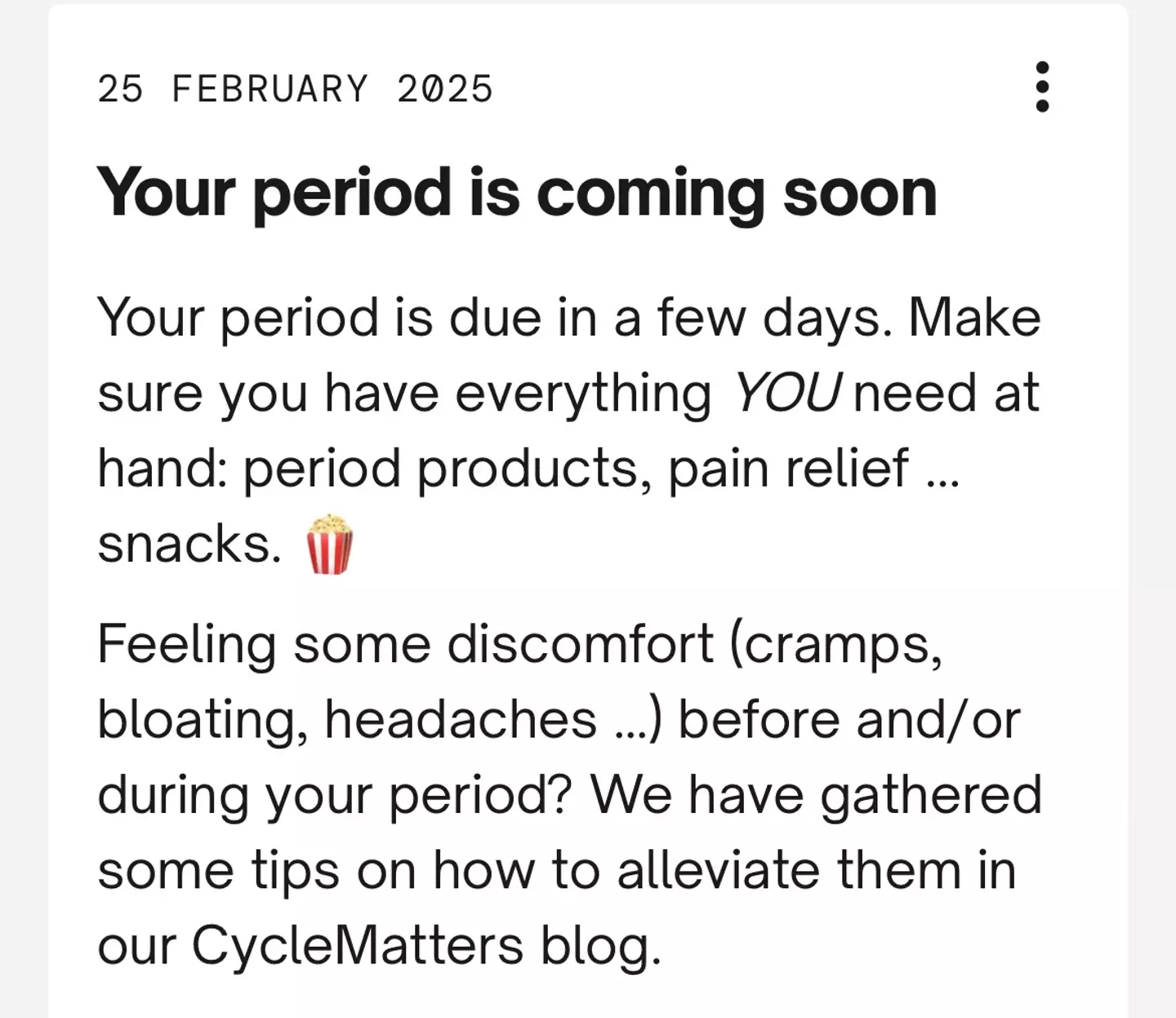

Natural Cycles will sync to your Oura app for an even deeper understanding of your cycle
Chief Product Officer at Oura, Holly Shelton, helped to develop Cycle Insights and hopes it can help women to gain a deeper understanding of their menstrual cycle.
“The Oura Ring is designed to help women take control of their personal health journey, tracking their menstrual cycles with precision by offering continuous temperature monitoring to detect cycle phases and predict key hormonal shifts,” Shelton tells UNILAD Tech. “With Cycle Insights, women can track their menstrual cycle with confidence, gaining clarity on patterns, symptoms, and recovery needs.”
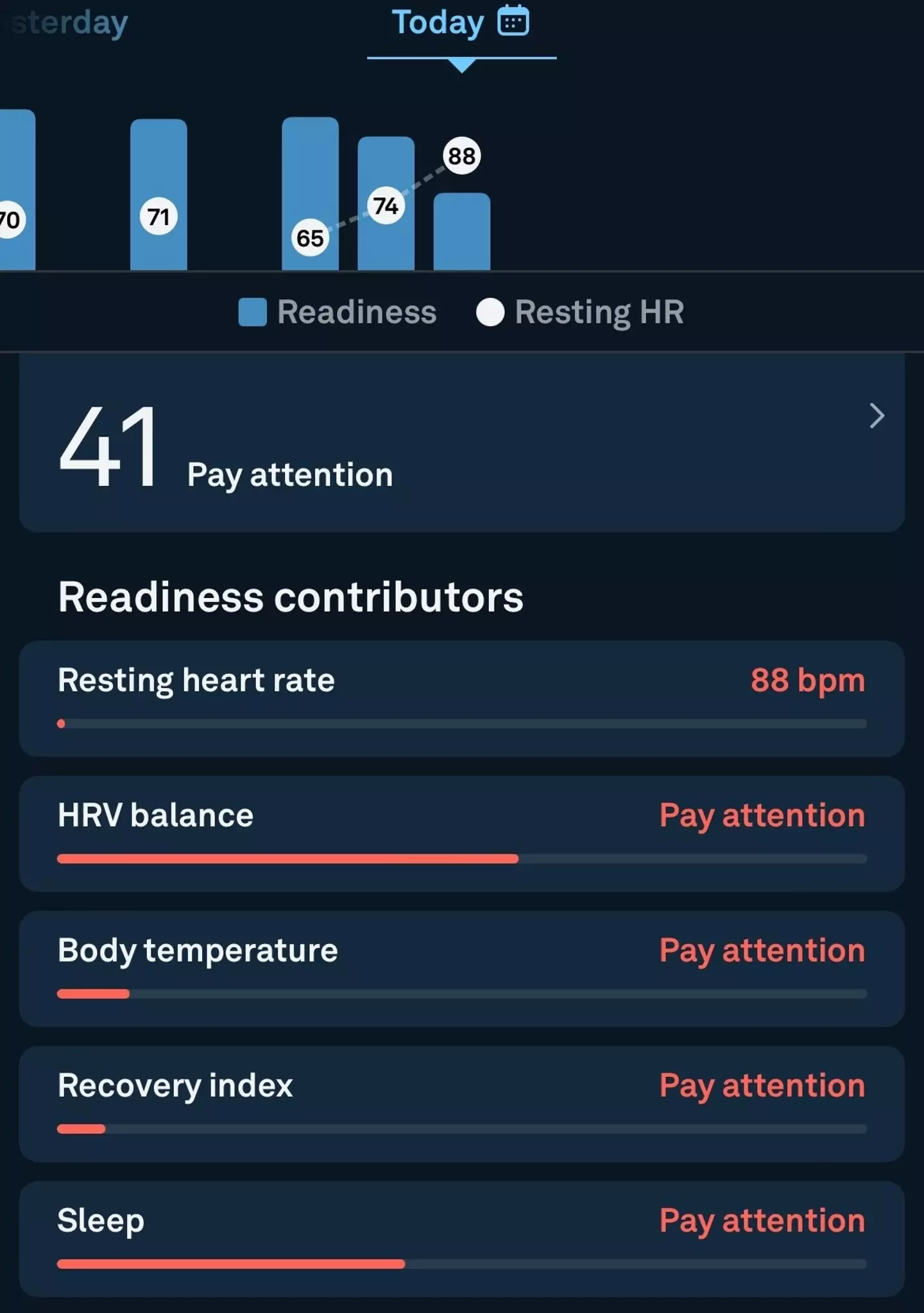

The app will give you a ‘readiness’ rating each morning
To gain an even deeper understanding of my menstrual health, I also downloaded fertility app Natural Cycles, which syncs up with the Oura Ring so that you can accurately track symptoms during your cycle such as ‘bloating’ or ‘fatigue’.
“Through the Oura app, users can ‘tag’ different stages of their cycle to gain a better understanding of how their cycle influences sleep, activity, and overall wellbeing,” Shelton adds.
“Integrations with leading fertility apps like Natural Cycles help further support our members, changing the way women understand and navigate their reproductive health.”
Each morning, the Oura app will give me a ‘resilience’ score out of 100, taking into account how much sleep I’ve had, daytime stress load, readiness, and activity. There’s no hiding from the app either, as it can tell when I’ve had a few at the pub or eaten late-night snacks in bed, as it will negatively impact my sleep score.
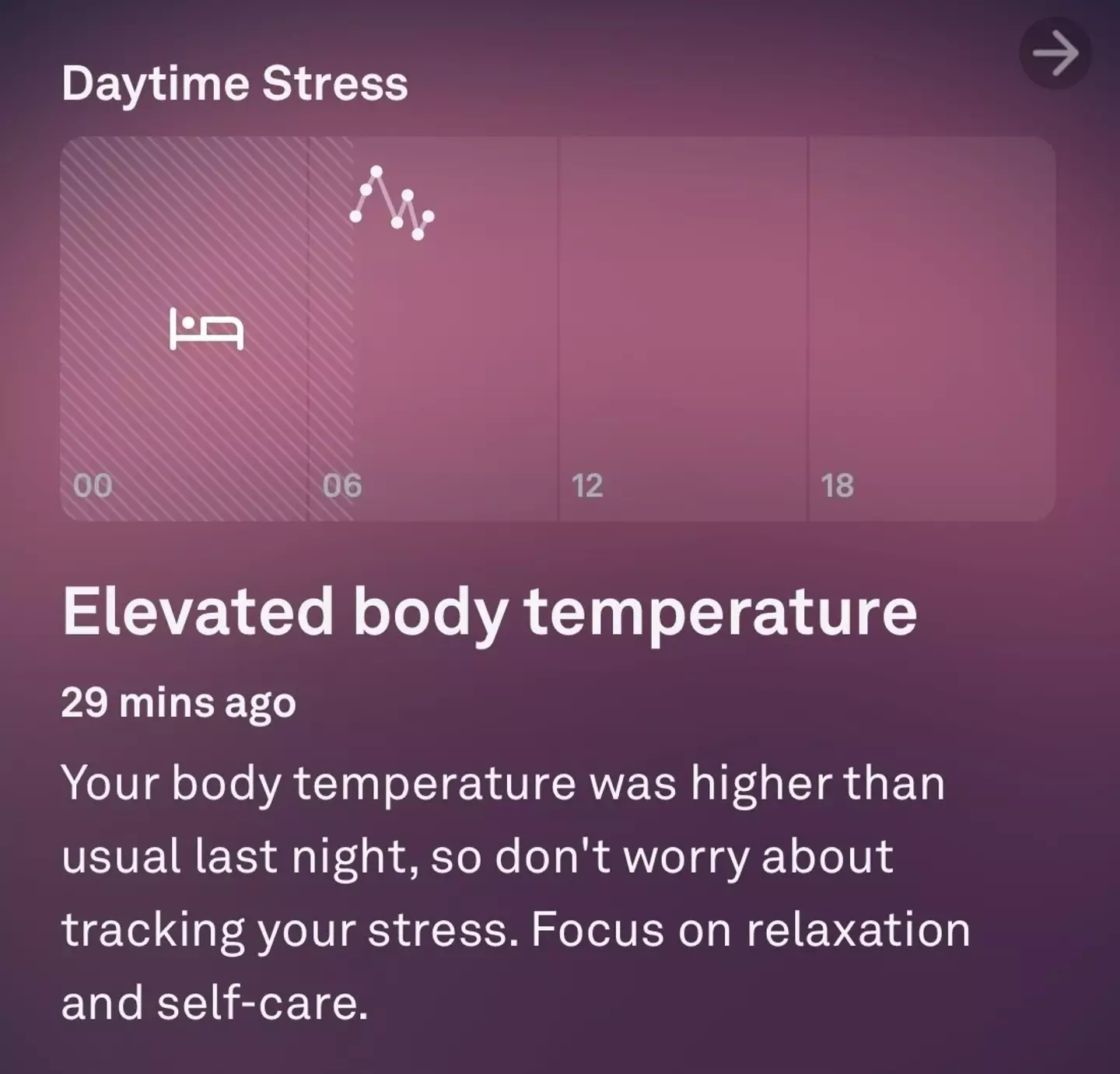

The smart ring measures your temperature during the luteal phase
The most surprising thing that happened during the review? The Oura app knew I was poorly, before I even had symptoms. When I checked the app one morning, it alerted me to ‘major signs’ of something straining my body. My HRV, sleep, and readiness levels were all in the red, but I felt fine.
Fast forward 24 hours, and I was lying in bed with the flu.
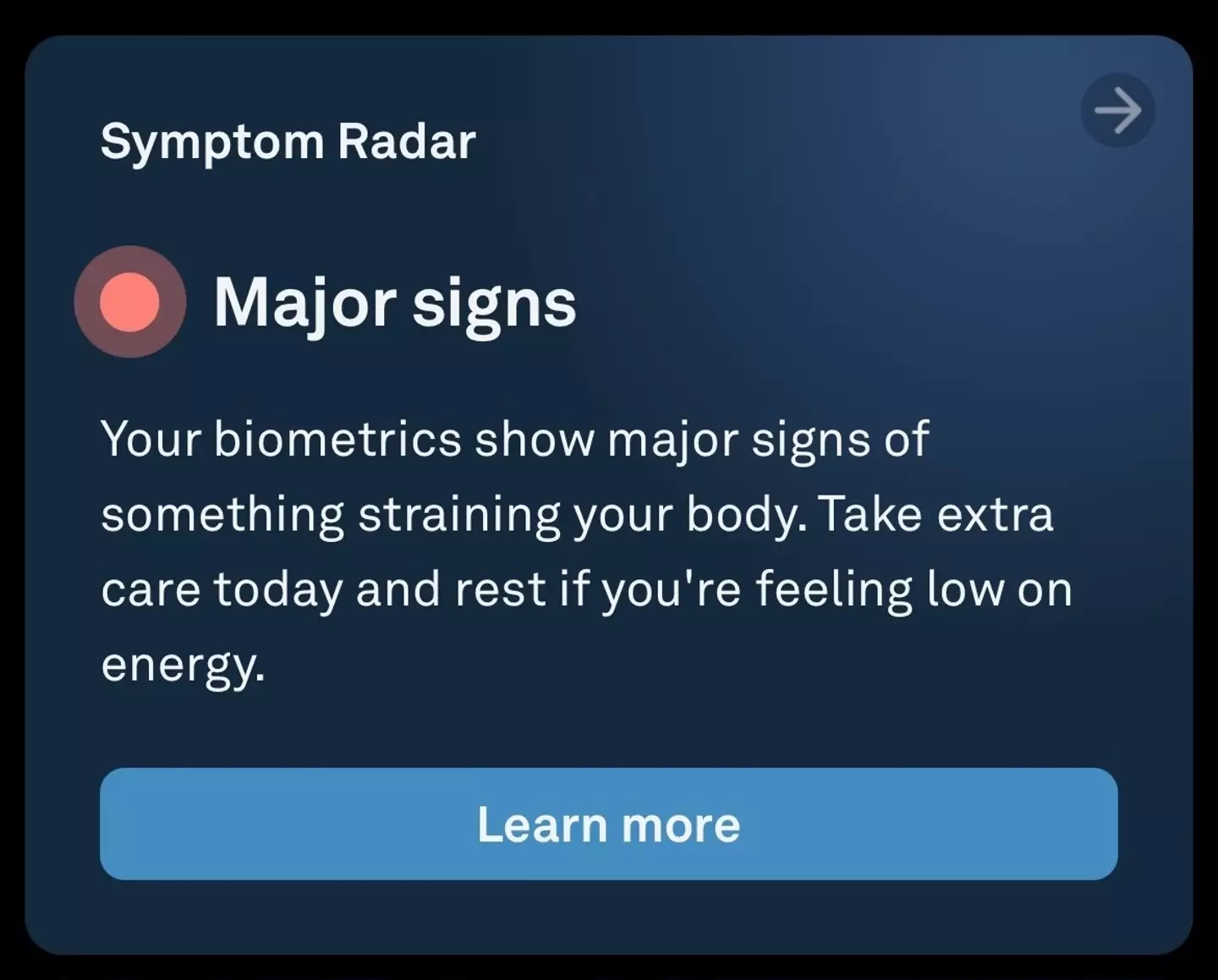

The Oura app knew I was unwell before I even had any symptoms
Since wearing the Oura Ring, I’ve gained a deeper understanding of my health and menstrual cycle, and have tailored my diet, fitness, and sleep schedule to align with this.
Oura is the first app I check in the morning, keen to see how I have slept, and the last app I check before turning out the lights.
I’m in it for the long run, too. I sleep in it, exercise in it, and even shower in it. I have only ever taken the ring off to charge it, and much to my surprise, it’s still in great condition – bar a couple of scratches.


The gold colourway starts from $499
The Oura Ring 4: Cons
I know what you’re thinking, it’s expensive. The Oura Ring 4 starts from $349 and you need to pay for a monthly membership ($5.99) on top of this. But if budget allows, and you want to track your menstrual cycle more accurately, I’d say it’s well worth the price tag. At the time of writing this, you can receive four weeks of Natural Cycles for free too, if you purchase the Oura Ring on the official website here.
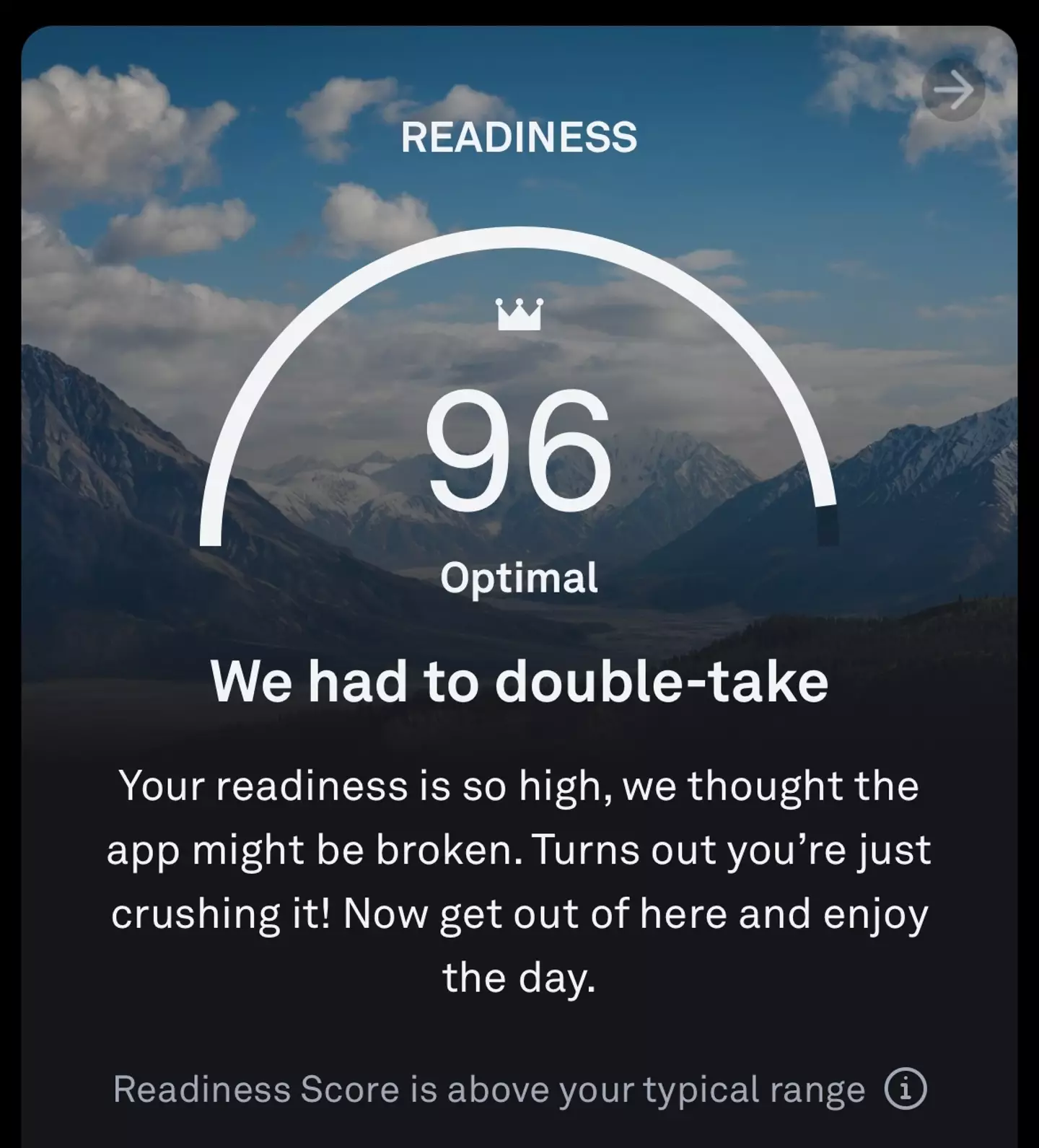

Nothing beats a compliment from the Oura app
Where to buy the Oura Ring 4 now
The Oura Ring 4 is now available on the official website. You will receive a complimentary sizing kit in the post, where you can try different sizes to find a comfortable fit. Then, all you need to do is download the app, charge the ring, and you’re good to go.
Since wearing the Oura Ring, a couple of women have come up to me in public to ask whether it’s worth the investment.
I tell them that for the first time in my life, I feel more in control of my health, and you can’t put a price on that.
Visit the Oura website now to find out more.
Featured Image Credit: LADbible Group


You don’t have to keep telling us, yes, we know exercising is good for your body. Still, when you’ve had a long day at work and the cold weather sets in, the last thing you want to do is go for a 5k run.
From releasing endorphins to dropping a couple of inches around your waist, it’s easy to see the benefits of exercising, but if only it was that simple. With January well underway, many of us have likely hit the gym as part of our New Year’s resolutions.
While those numbers are sure to plummet at the start of February and then trail off until another boost in January 2026, there are plenty of YouTube videos out there explaining why we should keep at it.
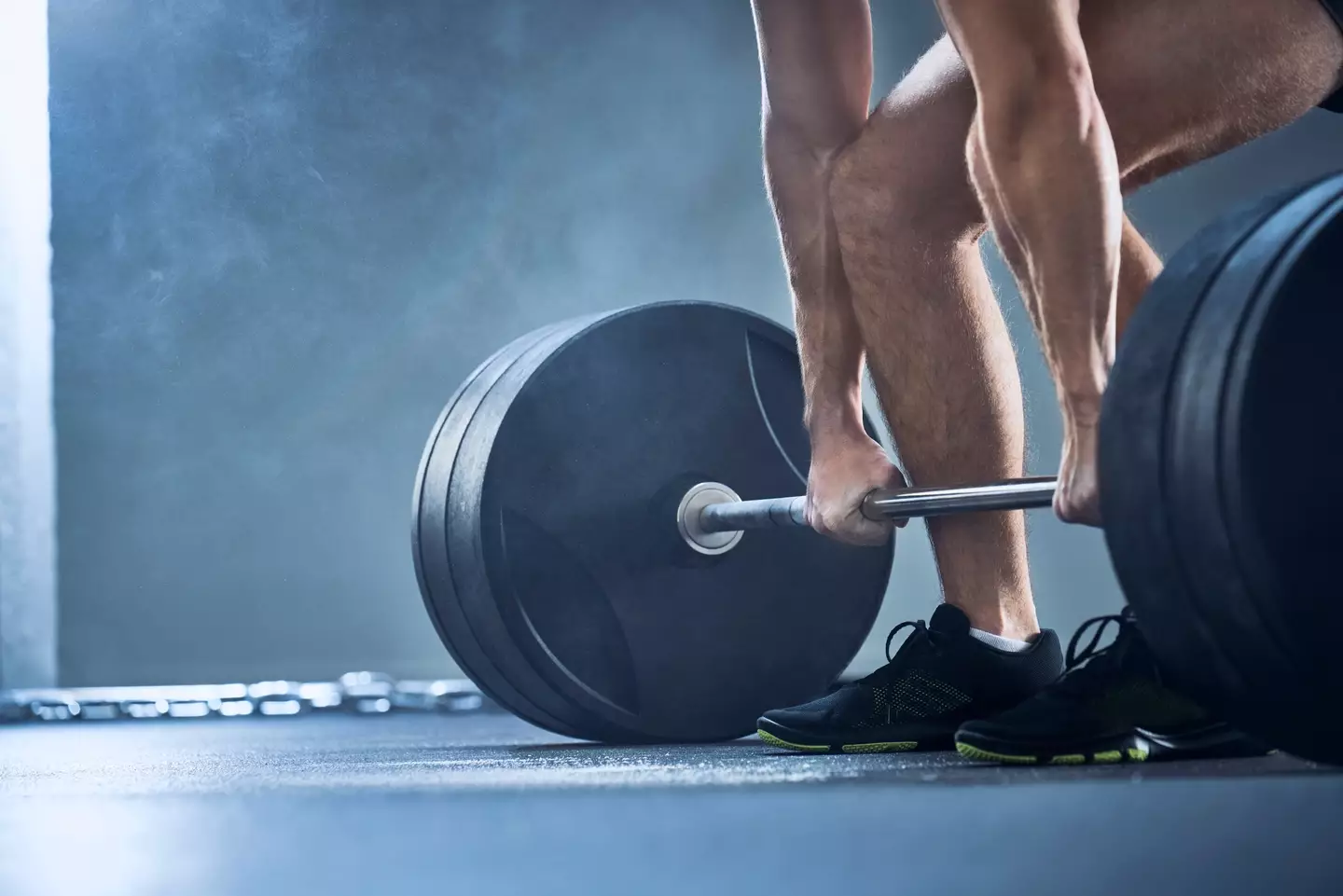

It’s important to find a healthy balance when working out (Westend61 / Getty)
One video from The Infographics Show explains exactly what happens to our bodies when we exercise – including some of the benefits we might not have thought about.
We’re told that a slight burn is an important process because it helps your muscles get stronger. In terms of physical changes, blood is shifted from your digestive system to your skeletal muscles, while your brain and hormones from your endocrine system instruct your body to convert stored sugars from fat and carbs into glucose for energy.
The release of lactic acid will cause pain that makes you think you can’t do any more reps, but over time, your body will metabolize it and you’ll be able to carry on.
Your body temperature increases and your sweat glands produce sweat to try and cool you down, which is why it’s important to stay hydrated during your workouts.
Sleep is also important following a workout because your body is putting itself into a state of repair. Stretching is key to keeping muscles pliable and helping them grow, with the video also suggesting that 45 minutes of ‘intense’ exercise can lead to your metabolism increasing by up to 40% for 14 hours after you’ve finished your workout.
One side effect you might not expect is that working out can cause the release of certain hormones that could decrease your appetite. Still, that doesn’t mean you won’t be famished after some workouts.
Even though you won’t have abs of steel after a week, you can make the most of endorphin hormones sending pleasure signals to your brain when you work out. Researchers suggest this changes the way you think about exercising and it could almost become a pleasurable experience.
Unfortunately, the lack of seeing results after a week is where many people tend to falter, thinking it’s not worth it and going back to their normal routine without hitting the gym.
After about three months, you’ll likely see physical changes, although be warned that you might actually put on weight due to your bigger muscles. There’s also the side effect that not working out might lead to you feeling low because your body is used to the endorphin kick.
Telling us to stick with it, the video reminds us that working out typically leads to a stronger heart, as well as reducing our risk of heart disease, stroke, and Type 2 diabetes.
On the flip side, we’re also warned about the dangers of exercising too much. The Infographics Show says overworking your muscles can lead to them breaking down in a rare condition called rhabdomyolysis – which can lead to major organ failure.
If your body needs more nutrients than you’re providing, it can cause hair loss and bone pain. Basically, it’s all about respecting balance, and as long as you’re not pushing your body to the extreme, the benefits of exercising far outweigh the negatives.
Featured Image Credit: The Good Brigade / Oscar Wong / Getty


Dry January is an incredibly popular event at the start of the new year, challenging people to give up alcohol for a whole month, and the effects it has on your body are likely to shock you.
Most people enjoy an alcoholic beverage every once in a while, but many have taken it upon themselves to give it up completely during January at the start of every year.
Started initially by Alcohol Change UK in 2013, hundreds of thousands of people sign up every year with far more taking on the challenge unofficially, but have you ever wondered exactly what effect Dry January has on your body and your health?


Taking part in Dry January can have a number of positive effects on your health (Michael M. Santiago/Getty Images)
As reported by Science Alert, the effects of undertaking a month of no alcohol are not only positive but fast-acting too, with respondents indicating improvements to their health in a number of bodily areas.
From a purely scientific perspective, biological studies indicate that taking a break from the booze reduces your liver fat, blood glucose, and blood cholesterol levels, all of which are positive for your overall health.
Perhaps the most illuminating discovery is that reducing your alcohol intake appears to dramatically increase the quality of your sleep. 56% of respondents to a survey conducted by Science Alert and Alcohol Change UK indicated that their sleep improved by the end of Dry January, and the health benefits of a better sleep are well documented.
Similar numbers also indicated that they had increased energy levels, alongside feeling healthier overall, and if you’re one for saving money then 63% of participants outlined that not drinking helped their purse out too.
Undertaking the process of Dry January isn’t for everyone though, and it can actually be harmful depending on your level of alcohol dependency.
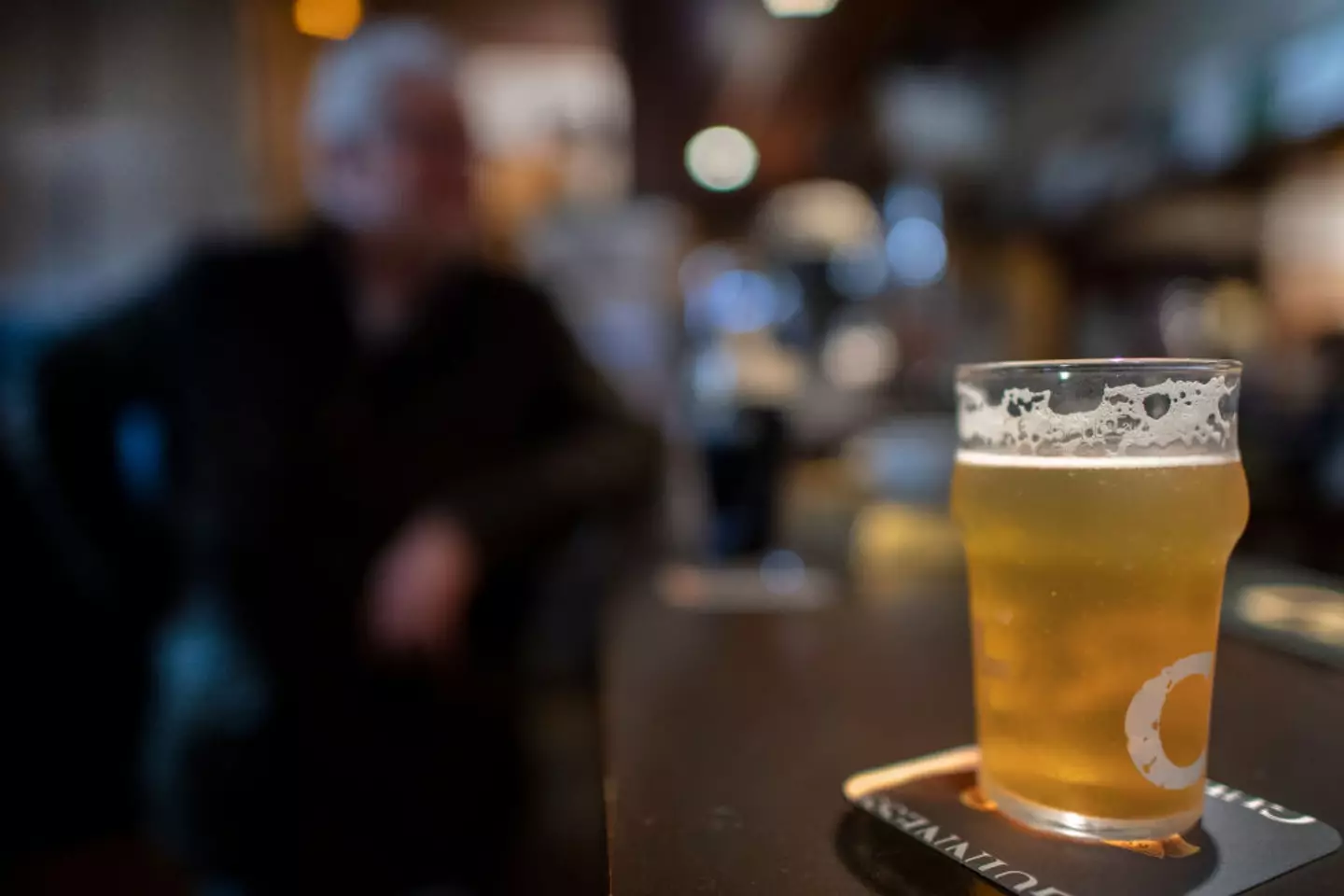

For some it isn’t as simple as putting the pints down, as they experience severe and harmful withdrawal symptoms (Fred Tanneau/AFP via Getty Images)
One commenter on Reddit outlined: “So was trying Dry January and couldn’t. It’s made me realize I don’t just have a drinking problem, I have proper alcohol dependence, with withdrawal effects and missing work and everything.”
As it’s very much a drug, going cold turkey with alcohol can have some incredibly damaging withdrawal symptoms, with other posts indicating that people “didn’t sleep well,” and had “night sweats for a few days.”
Subreddits like r/DryJanuary and r/stopdrinking provide support for people going through issues like this though, and it goes to show that while taking the plunge can be a healthy break for some, it isn’t always cut and dry if you typically drink far more than the average.
Featured Image Credit: Klaus Vedfelt / Getty


We all know what it’s like when we first get out of bed in the morning and are in desperate need of a cup of coffee to help us out of the door.
It’s an energy boost many of us rely on to get us through the day but what happens to our bodies when we stop drinking coffee?
Well, one shocking simulation reveals everything that happens when we deprive our bodies of caffeine.
Posted to YouTube by The Infographics Show, the video sheds some light on the science behind it.
The clip explains: “So basically, the caffeine in coffee is tricking your body into producing chemicals that make you happy and more alert.
“This feeling is a good one, and therefore your body doesn’t want to give it up easily.”
It goes on to add: “Besides increasing the concentration of dopamine in your body to make you feel happy, caffeine also tricks the brain into thinking there is an emergency, which some scientists think may cause adrenaline to be released.
“This is another reason why coffee makes you feel so awake.”
So what happens when you stop drinking coffee? Well, the ‘highest caffeine levels your body will experience occur about an hour after you finish your cup of coffee,’ says the video, but ‘from then on, it will be all downhill’.
It goes on to say: “After about an hour, your body slowly starts to use up all of the caffeine that is circulating through your bloodstream.”


Your body goes into withdrawal when you stop drinking coffee (Stefania Pelfini, La Waziya Photography/Getty Images)
According to a study conducted in Psychopharmacology, that consisted of a compilation of 170 years of research, ‘the symptoms of caffeine withdrawals can start as early as 12 hours after your last cup of coffee’.
Symptoms you may notice when you stop drinking coffee include being more irritable which is due to an ‘imbalance of hormones’.
You may also experience a lack of energy and anxiety.
The video goes on to explain: “You could end up feeling a lack of productivity for the entire week.
“Luckily there is also good news. In several research studies it was found that after people got over their caffeine withdrawal, their productivity exceeded what it was before.
“This is because caffeine may give someone more focus when consumed daily, but it is artificial.
“When the body is allowed to operate at optimum levels without the aid of an outside drug, you can be more productive for longer periods of time.”
Featured Image Credit: YouTube/@TheInfographicsShow/Stefania Pelfini, La Waziya Photography/Getty Images


A new simulation shows what vaping does to your lungs and it’s not pretty.
We all know vaping isn’t exactly good for us. Whilst it’s pitched as a safer alternative to smoking, it doesn’t mean it’s risk-free.
More worryingly, it’s also become a huge trend among younger generations. According to Action on Smoking and Health (ASH), in 2024, 18% of 11–17-year-olds had tried vaping, and 7.2% were current vapers.
That said, the consequences of long-term vaping on our health are yet to be discovered, according to the NHS.
Yet hearing stories like the man who had only a 1% chance of survival after getting hooked on vaping, or the 17-year-old who needed surgery to remove part of her lung is enough to make you put that berry-flavoured pen down for good.


chuchart duangdaw / Getty
Now, what actually happens when we ingest the chemicals has been terrifyingly illustrated in a simulation on YouTube.
Thanks to The Infographics Show, we can understand what happens to your lungs when you take a hit of an e-cigarette.
When you inhale from a vape, chemicals coat your lungs, leading to a mucus buildup on the alveoli (the tiny air sacs that help you breathe). The simulation shows that the chemicals can have a damaging ‘paralytic effect’ on the lungs and the cilia.
It takes weeks for them to recover, and during that time, your body is way more vulnerable to infections and respiratory issues.
“Research on vaping-related harm is rapidly developing. Current evidence suggests vapes are less harmful than smoking tobacco products, but they aren’t risk-free,” the NHS states.
Most vapes contain nicotine, which is highly addictive. They also contain other chemicals like propylene glycol, glycerine and flavourings – none of which belong in your lungs, the NHS explains.
One of the biggest concerns with vaping is its appeal to teenagers. With flavours like bubblegum and blue raspberry, it’s attracting the eyes of younger people who are getting hooked to this relatively new phenomenon.
A 2023 study found that 4.6% of middle school students (ages 11-14) and 10% of high school students (ages 14-18) reported using e-cigarettes, according to the CDC. That adds up to 2.13 million students in the US alone.
The science is still lacking in this area, especially on the long-term effects of vaping. But some research is starting to connect the dots.
A recent study in The Journal of Nuclear Medicine compared lung inflammation in vapers vs. non-smokers.
It turns out those who used e-cigarettes were associated with lung inflammation and inflammatory lung disease, both causing wheezing, breathing problems, and chest pain and tightness, as per Very Well Health.

